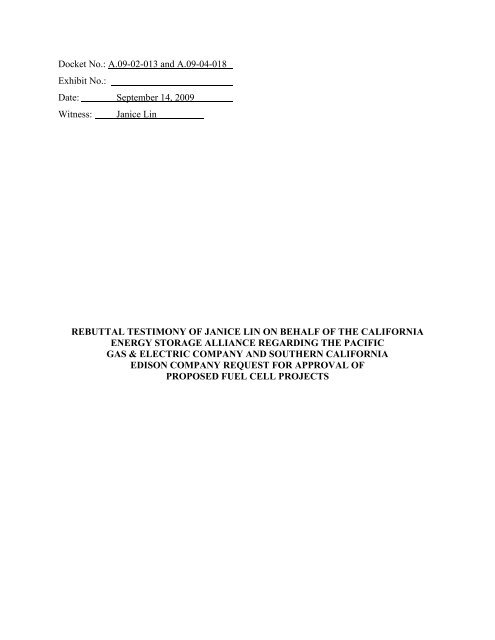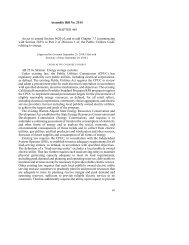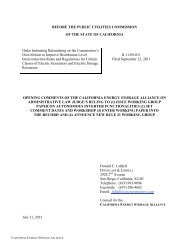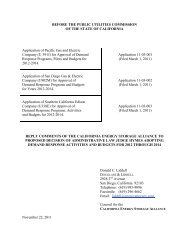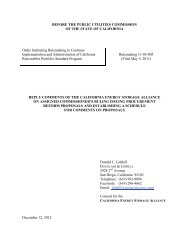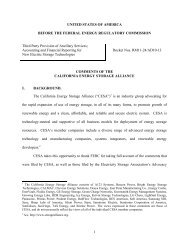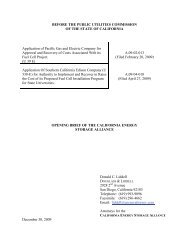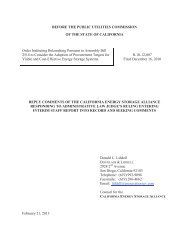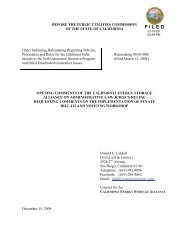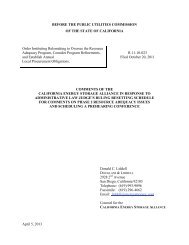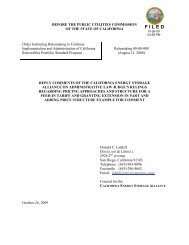Rebuttal Testimony of Janice Lin re SCE's Fuel Cell Application
Rebuttal Testimony of Janice Lin re SCE's Fuel Cell Application
Rebuttal Testimony of Janice Lin re SCE's Fuel Cell Application
You also want an ePaper? Increase the reach of your titles
YUMPU automatically turns print PDFs into web optimized ePapers that Google loves.
Docket No.: A.09-02-013 and A.09-04-018Exhibit No.:Date: September 14, 2009Witness: <strong>Janice</strong> <strong>Lin</strong>REBUTTAL TESTIMONY OF JANICE LIN ON BEHALF OF THE CALIFORNIAENERGY STORAGE ALLIANCE REGARDING THE PACIFICGAS & ELECTRIC COMPANY AND SOUTHERN CALIFORNIAEDISON COMPANY REQUEST FOR APPROVAL OFPROPOSED FUEL CELL PROJECTS
REBUTTAL TESTIMONY OF JANICE LIN ON BEHALF OF THE CALIFORNIAENERGY STORAGE ALLIANCE REGARDING THE PACIFICGAS & ELECTRIC COMPANY AND SOUTHERN CALIFORNIAEDISON COMPANY REQUEST FOR APPROVAL OFPROPOSED FUEL CELL PROJECTS12345I. IntroductionThe California Energy Storage Alliance (“CESA”) filed opening testimony to add<strong>re</strong>ssSouthern California Edison Company’s (“SCE’s”) <strong>re</strong>quest to the Commission to utilize SelfGeneration Incentive Program (“SGIP”) funding to <strong>of</strong>fset 50% <strong>of</strong> the initial capital cost <strong>of</strong> itsproposed development <strong>of</strong> th<strong>re</strong>e fuel cell installations <strong>of</strong> up to 3 MW at various state universities6in SCE’s service territory. 1In this <strong>re</strong>buttal testimony, CESA (i) provides further information to78910support its Protest to SCE’s <strong>Application</strong> based on developments since its opening testimony wasserved on September 14, 2009, and. (ii) <strong>re</strong>sponds to the opening testimony <strong>of</strong> TURN. It isbecoming clea<strong>re</strong>r every day that the SGIP budget that SCE seeks to tap into for its own use is arapidly moving target for eligible SGIP funding applicants to <strong>re</strong>ly on in planning their projects.1112II.SCE’s Claim Of ‘Underutilized Funding’ Is Clearly P<strong>re</strong>matu<strong>re</strong>.Uncertainty as to the availability <strong>of</strong> budgeted SGIP funds is accelerating due to a number <strong>of</strong>131415161718internal and external events in addition to SCE’s attempt to convert the SGIP to a funding sourcefor utility projects. The Commission itself is calling for <strong>re</strong>view <strong>of</strong> the SGIP budget, and theutilities a<strong>re</strong> seeking to divert the cur<strong>re</strong>nt budget to causes in an appa<strong>re</strong>ntly random manner. Fromthe perspective <strong>of</strong> an eligible SGIP applicant, these cumulative events <strong>re</strong>sult in dramaticuncertainty in the availability and amount <strong>of</strong> SGIP funds. Because significant developmentcapital must be expended over a long period <strong>of</strong> time to develop an eligible SGIP project, this1 SCE’s application was consolidated with a similar application <strong>re</strong>lated to Pacific Gas and Electric Company by ALJDuda in her ruling from the bench at the June 22 p<strong>re</strong>hearing confe<strong>re</strong>nce that granted the May 19, 2009 motion toconsolidate filed by the Division <strong>of</strong> Ratepayer Advocates (“DRA”). This ruling was subsequently confirmed in theAssigned Commissioner’s and Administrative Law Judge’s Scoping Memo and Ruling issued June 25, 2009(“Scoping Memo”).1
1234567uncertainty will negatively impact the likelihood <strong>of</strong> successful SGIP project development byeligible applicants, particularly for energy storage.First, On September 17, 2009, Administrative Law Judge J. Dorothy Duda issued anAdministrative Law Judge’s Ruling Requesting Comments on the Self Generation IncentiveProgram Budget for 2010 and 2011 (“SGIP Budget Ruling”), seeking comments on a proposalfor simplifying the SGIP budget and carryover funding for 2010 and 2011 and <strong>re</strong>ctifyingir<strong>re</strong>gularities among the four investor owned utilities (“IOUs”) in their accounting for SGIP8funds. 2In seeking comments, the SGIP Budget Ruling identified certain <strong>re</strong>levant background9101112131415161718192021information, with salient points including:Legislation awaiting the Governor’s signatu<strong>re</strong> (SB 412, Kehoe would allow collections fromratepayers for SGIP in 2010 and 2011, extend administration <strong>of</strong> the program until January 1,2016, and expand program eligibility to distributed non-generation <strong>re</strong>sources that manage peakload and achieve <strong>re</strong>ductions in g<strong>re</strong>enhouse gas emissions.Energy storage technologies a<strong>re</strong> allowed to <strong>re</strong>ceive incentives <strong>of</strong> $2 per watt when coupledwith SGIP eligible generation technologies.A pending decision in the proceeding would approve a petition by Bloom EnergyCorporation to expand eligibility for <strong>re</strong>newable incentives for SGIP projects that use fueldelive<strong>re</strong>d through di<strong>re</strong>cted biogas contracts. 3The SGIP Budget Ruling also di<strong>re</strong>cted PG&E, SCE, SoCalGas, and SDG&E, incooperation with CCSE, to verify the accuracy <strong>of</strong> SGIP funding data in attached Tables throughSeptember 1, 2009.222 Opening Comments we<strong>re</strong> <strong>re</strong>qui<strong>re</strong>d to be filed by September 28, 2009, and Reply Comments we<strong>re</strong> due on October5, 2009.3 The petition was subsequently approved and D.0909-048 was issued on September 24, 2009.2
1234On September 23, 2009, ALJ Duda issued a Partial Extension for SGIP Budget Dataallowing the IOUs an extension <strong>of</strong> time to file the <strong>re</strong>qui<strong>re</strong>d budget data until the date <strong>of</strong> this<strong>re</strong>buttal testimony, October 5, 2009. The deadline to file Reply Comments on October 5, 2009<strong>re</strong>mained unchanged. Along with other parties, CESA filed Opening Comments <strong>re</strong>sponding to5the SGIP Budget Ruling on September 28, 2009. 4Whether any Reply Comments will have been67891011121314151617181920212223filed by the close <strong>of</strong> business today is unknown; and CESA does not have access to any budgetdata that may have been submitted pursuant to the SGIP Budget Ruling.Second, PG&E was also among the parties that filed Opening Comments, including thefollowing <strong>re</strong>markable topic in addition to those raised by the SGIP Budget Ruling:“In addition to the issues listed is the Ruling, the<strong>re</strong> a<strong>re</strong> two other topicsthat should be raised. First, the<strong>re</strong> a<strong>re</strong> additional parties seeking to spend SGIPfunds. In <strong>Application</strong> 09-02-013, PG&E seeks to <strong>re</strong>cover the cost <strong>of</strong> th<strong>re</strong>e Utilityowned fuel cell projects, and TURN has suggested that rather than rate basing theprojects, the costs should be taken from the SGIP budget. In addition, PG&Efiled an Advice Letter on September 11, 2009, <strong>re</strong>questing the authority to use upto $7 million in SGIP funds to inc<strong>re</strong>ase funding for PG&E’s Relief for EnergyAssistance through Community Help Program. (AL 3045-G/3522-E). If eitherproposal is approved, this may affect the SGIP dollars that need to be <strong>re</strong>cove<strong>re</strong>dfrom ratepayers.Second, the<strong>re</strong> a<strong>re</strong> a number <strong>of</strong> issues not add<strong>re</strong>ssed in the Ruling thatwould need to be add<strong>re</strong>ssed if these suggestions a<strong>re</strong> approved. For example, if nonew SGIP program budget dollars a<strong>re</strong> permitted after 2011, but the programcontinues until 2015, then the dropout and waiting list rules might need to be4 CESA’s Opening Comments we<strong>re</strong> necessarily qualified by a <strong>re</strong>servation <strong>of</strong> rights as to any material informationprovided in <strong>re</strong>sponse to the SGIP Budget Ruling.3
123456789101112131415augmented and clarified, as the<strong>re</strong> may be a large waiting list for availabledollars.” (PG&E Opening Comments, p. 5).PG&E’s Opening Comments di<strong>re</strong>ctly add<strong>re</strong>ss the uncertainty <strong>of</strong> the budget given itsmany alternative uses. Finally, it should be noted that on the same day that opening testimonywas due in this proceeding the Commission approved a <strong>re</strong>solution granting Southern CaliforniaGas Company and San Diego Gas and Electric Company the authority to inc<strong>re</strong>ase funding forun<strong>re</strong>lated programs by transferring funds from the SGIP: “On February 20, 2009, SDG&E andSoCalGas (the Joint Utilities) submitted advice letter filings seeking Commission authorizationto transfer funds from their over-collected balancing accounts; the Rate Design SettlementComponent Balancing account (“RDSBA”), the Post-2005 Gas Energy Efficiency BalancingAccount (“PGEEBA”), and the Self Generation Program Memorandum Account (“SGPMA”) toinc<strong>re</strong>ase funding for their charitable Neighbor-to-Neighbor (“NTN”) and Gas Assistance Fund(“GAF”) programs. The NTN and GAF funds help pay electric and gas bills <strong>of</strong> customersexperiencing temporary financial hardship. These programs a<strong>re</strong> funded by sha<strong>re</strong>holders,utilities’ employees and voluntary contributions from ratepayers.” 51617III.<strong>Rebuttal</strong> to TURNTURN notes that PG&E proposes to construct its th<strong>re</strong>e fuel cell projects with sha<strong>re</strong>holder1819202122capital and rate base the assets, while SCE proposes to expense approximately 50% <strong>of</strong> theestimated installed capital costs ($10.8 million) using a portion <strong>of</strong> the uncommitted balance inthe SGIP Inc<strong>re</strong>mental Cost Memorandum Account, used to fund projects subsidized through theSGIP. TURN uncritically accepts SCE’s argument in the <strong>Application</strong> that using SGIP funds isconsistent with state policy. Based on that assumption, without any analysis or explanation,5 Resolution E-4251, at p. 1. Ordering Paragraph Number 3 stated, “The funds authorized under this <strong>re</strong>solution a<strong>re</strong>for one time only and its approval is not meant to set any p<strong>re</strong>cedent for futu<strong>re</strong> funding <strong>of</strong> this or any other similarprogram.” (at page 17).4
1TURN concurs “that it is appropriate to use SGIP funds for these projects.” 6TURN then goes23456789101112131415161718192021even further and <strong>re</strong>commends that “the Commission authorize both SCE and PG&E to expenseall capital costs for the fuel cell installations from SGIP funds.” 7 Of course, it is impossible tosqua<strong>re</strong> testimony with TURN’s Protest: “The state has implemented a ratepayer subsidy programto private installations <strong>of</strong> fuel cells through the Self-Generation Incentive Program. However,that program in no way enunciates a policy <strong>of</strong> promoting full ratepayer payment for utilityownership <strong>of</strong> fuel cells. A public policy that promotes “public-private” partnership by providinga partial subsidy for private installations is not equivalent to a policy that supports full publicownership <strong>of</strong> the installation. [Emphasis in original]” 8CESA understands TURN’s frustration with the costs <strong>of</strong> the utilities’ fuel cellapplications and the burdens they will undoubtedly place on all ratepayers. Nevertheless,TURN’s understandable concern over the high costs <strong>of</strong> the proposals is not a <strong>re</strong>asonable groundon which to blithely igno<strong>re</strong> state law and raid the SGIP funds when Commission policy exp<strong>re</strong>sslyprohibits utilities from using SGIP funds to fund utility projects. 9 As noted in CESA’s openingtestimony, this policy was established in D.01-03-073, which provides in pertinent part: “Thefollowing entities a<strong>re</strong> not eligible for incentives under this program: Utility distributioncompanies themselves or their facilities.” 10 (Emphasis added) As CESA and other parties 11explained in opening testimony, in D.04-12-045, the Commission clarified this policy as follows:“Decision 01-03-073 prohibited utility distribution companies from <strong>re</strong>ceivingSGIP incentives. The Working Group seeks clarification as to which distributioncompanies a<strong>re</strong> excluded from the program.6 TURN opening testimony at p. 9.7 Id, emphasis in original.8 TURN Protest, at p. 2.9 SCE <strong>Application</strong>, at p. 4.10 D.01-03-073, Attachment 1, at p. 25.11 Western Power Trading Forum (“WPTF”), at pp. 11-12; Debenham Energy, LLC (“Debenham”), at pp. 3-4;Division <strong>of</strong> Ratepayer Advocates (“DRA”), at pp. 7-8.5
12345678910111213We clarify that public and investor-owned gas or electricity distribution utilitieswhich generate or purchase electricity or natural gas for wholesale or <strong>re</strong>tail sales,a<strong>re</strong> not eligible to <strong>re</strong>ceive incentives.” 12Given the Commission’s clear and unambiguous prohibition on the use <strong>of</strong> SGIP funds byutilities, the Commission should categorically <strong>re</strong>ject TURN’s proposal that both SCE and PG&Eshould be permitted to expense all capital costs for the fuel cell installations from SGIP funds.Allowing SCE to utilize a significant portion <strong>of</strong> finite SGIP funding for utility-owned fuel cellprojects would not only set a dangerous p<strong>re</strong>cedent, but would also certainly <strong>re</strong>duce availablefunding to qualified applicants for all <strong>of</strong> the eligible technology classes. Successful marketdevelopment <strong>re</strong>qui<strong>re</strong>s certainty and time. If SCE we<strong>re</strong> allowed to igno<strong>re</strong> an obvious conflict <strong>of</strong>inte<strong>re</strong>st to utilize SGIP funds for their own Project, this would have a ‘chilling’ effect on thecommercial market for all eligible technologies as it would call into question the availability <strong>of</strong><strong>re</strong>maining funds for private sector development.1415IV.RecommendationThe Commission should dis<strong>re</strong>gard TURN’s Opening <strong>Testimony</strong> and <strong>re</strong>ject SCE’s1617proposal to use SGIP funds for its Project. Absent the imposition <strong>of</strong> this condition, theCommission should <strong>re</strong>ject the SCE application enti<strong>re</strong>ly. This completes my <strong>re</strong>buttal testimony.12 D.04-12-045, at p. 23 (emphasis added).6


